This review in large part is intended as a comparison to Shure's PSM900 IEM system reviewed earlier. I'm not going to repeat much of the background information, thus you might want to read the PSM900 post first.
Just did a gig a couple of days ago and one of the muso's let me borrow his G3 IEM system for this review.
Conclusion:
While it lacks some of the simplicity and polish of the PSM900, the Sennheiser G3 IEM is also a joy to use. Its feature set has more depth, particularly with EQ, is very well built, a bit noisier than the Shure and has a longer battery life. Price is also reasonable and everyone seems to be very happy with the sound. The Sennheiser has the best clip indicators in the industry - the entire LED display flashes red. Love that. Cute little red clip lights are fine for the studio, but in live sound things need to slap you in the face if possible.
Like the Shure, it has a nonintuitive number system for sensitivity that requires measurement to know what you're doing. One large issue that separates these units is that it's very important to optimize gain structure with the Sennheiser in order to keep the white noise (hiss) from becoming an issue. You should be doing this anyway, but the G3 design compromises demand it. You can get away with too little signal voltage on the Shure's inputs and still have a quiet system, but the downside to this "advantage" is huge.
Shure is gonna love me for this, but the PSM900 is effectively broken compared to the G3. I bought (4) channels of the PSM900 with an antenna combiner assuming it would at least equal the G3 system if not beat it sonically. It does neither. The 4dB of compression that the PSM900 forces on you for whatever reason dulls the sound enough that there are muso's that really don't like it, the others just don't know any better. This is completely unacceptable. Give me the noise back please, I'll optimize gain structure and have a true representation available for the musician of what he's doing on stage.
Transfer Function vs Input Level:
Because of the decision to avoid compression, the G3 has an effective dynamic range of about 40dB. Signals under that level will be noisy, particularly in the LF. Nevertheless, 40dB is fine with good gain structure. System latency is about 0.125ms. Low frequency extension is improved relative to the PSM900.
The G3 does not do compression, it tells the truth:
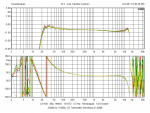
The G3 at -30dBu and -40dBu input levels with minimum sensitivity setting (don't do this):
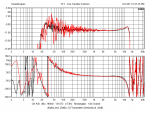
The PSM900 has a good 60dB dynamic range before audible noise but compresses the output as input level is increased.

Transfer Function vs Stimulus Type:
The Sennheiser's companding is like all the other such schemes I've measured - it expects a relatively full range stimulus instead of sine waves. Thus a swept sine shows the typical companding artifacts and pink noise shows what happens with real music. Red trace is swept sine, black is pink noise.
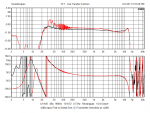
The PSM900 handles the swept sine stimulus a bit better. Notice how -50dBu and -40dBu measure the same as pink noise. Higher input levels confuse the companding - but in a musically useful way.

Transfer Function vs EQ:
The G3 has a huge amount of EQ capability. In my work, this is handled at the source by the console, but it would be very helpful in other situations such as small rigs and hearing impairment compensation. The beltpack is a simple on/off HF boost selection:
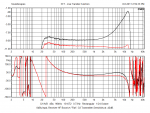
The much nicer EQ is found at the transmitter. HF boost including increments are shown here:
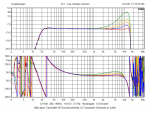
The remainder of the graphic EQ adjustments have the same increments, but I've only shown the extremes in the following. Notice how noise shows itself a bit in the LF maximum cuts when the input is driven by 0dBu at the minimum sensitivity setting.
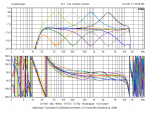
With the PSM900 the "flat" setting has HF boost of +1.5dB. The "+2dB" setting adds another 2.5dB and the "+4dB" setting might not sound as bright as the "+2dB" setting in some cases.

"Wireless looks like the innocent flower, but be the serpent under't." Macbeth (Act I, Scene III by William Shakespeare)
Just did a gig a couple of days ago and one of the muso's let me borrow his G3 IEM system for this review.
Conclusion:
While it lacks some of the simplicity and polish of the PSM900, the Sennheiser G3 IEM is also a joy to use. Its feature set has more depth, particularly with EQ, is very well built, a bit noisier than the Shure and has a longer battery life. Price is also reasonable and everyone seems to be very happy with the sound. The Sennheiser has the best clip indicators in the industry - the entire LED display flashes red. Love that. Cute little red clip lights are fine for the studio, but in live sound things need to slap you in the face if possible.
Like the Shure, it has a nonintuitive number system for sensitivity that requires measurement to know what you're doing. One large issue that separates these units is that it's very important to optimize gain structure with the Sennheiser in order to keep the white noise (hiss) from becoming an issue. You should be doing this anyway, but the G3 design compromises demand it. You can get away with too little signal voltage on the Shure's inputs and still have a quiet system, but the downside to this "advantage" is huge.
Shure is gonna love me for this, but the PSM900 is effectively broken compared to the G3. I bought (4) channels of the PSM900 with an antenna combiner assuming it would at least equal the G3 system if not beat it sonically. It does neither. The 4dB of compression that the PSM900 forces on you for whatever reason dulls the sound enough that there are muso's that really don't like it, the others just don't know any better. This is completely unacceptable. Give me the noise back please, I'll optimize gain structure and have a true representation available for the musician of what he's doing on stage.
Transfer Function vs Input Level:
Because of the decision to avoid compression, the G3 has an effective dynamic range of about 40dB. Signals under that level will be noisy, particularly in the LF. Nevertheless, 40dB is fine with good gain structure. System latency is about 0.125ms. Low frequency extension is improved relative to the PSM900.
The G3 does not do compression, it tells the truth:

The G3 at -30dBu and -40dBu input levels with minimum sensitivity setting (don't do this):

The PSM900 has a good 60dB dynamic range before audible noise but compresses the output as input level is increased.

Transfer Function vs Stimulus Type:
The Sennheiser's companding is like all the other such schemes I've measured - it expects a relatively full range stimulus instead of sine waves. Thus a swept sine shows the typical companding artifacts and pink noise shows what happens with real music. Red trace is swept sine, black is pink noise.

The PSM900 handles the swept sine stimulus a bit better. Notice how -50dBu and -40dBu measure the same as pink noise. Higher input levels confuse the companding - but in a musically useful way.

Transfer Function vs EQ:
The G3 has a huge amount of EQ capability. In my work, this is handled at the source by the console, but it would be very helpful in other situations such as small rigs and hearing impairment compensation. The beltpack is a simple on/off HF boost selection:

The much nicer EQ is found at the transmitter. HF boost including increments are shown here:

The remainder of the graphic EQ adjustments have the same increments, but I've only shown the extremes in the following. Notice how noise shows itself a bit in the LF maximum cuts when the input is driven by 0dBu at the minimum sensitivity setting.

With the PSM900 the "flat" setting has HF boost of +1.5dB. The "+2dB" setting adds another 2.5dB and the "+4dB" setting might not sound as bright as the "+2dB" setting in some cases.

"Wireless looks like the innocent flower, but be the serpent under't." Macbeth (Act I, Scene III by William Shakespeare)
Last edited:
